#Gertrude Agnew
Explore tagged Tumblr posts
Text

Lady Agnew of Lochnaw (1892) 🎨 John Singer Sargent 🏛️ National Galleries Scotland 📍 Edinburgh, Scotland
Sargent’s dazzling and unforgettable image of Lady Agnew is one of the most famous of his many portraits of fashionable London society. For both the artist and his sitter, the painting was an instant success, establishing Sargent’s reputation as the portrait painter of choice for the London elite and immediately transforming the newly elevated Lady Agnew into a society celebrity.
Sargent was born in Florence and spent his childhood travelling across Europe with his wealthy American parents who restlessly followed the changing social seasons. In 1874 he entered the Paris studio of the stylish French portraitist, Carolus-Duran. The young Sargent combined the flamboyant style of his teacher with his study of old masters such as Rembrandt and Velázquez but was also influenced by Monet and Impressionism. His provocative and unconventional Portrait of Madame X caused a scandal at the Paris Salon exhibition in 1884; and, when Sargent settled in London in 1886, he initially found it difficult to find clients as his bravura, continental style of painting attracted suspicion. However, his dashing technical mastery and confident manner were ideally suited for aristocratic patronage and he soon won over his critics with his elegant, flattering portraits. When his portrait of Lady Agnew was shown at the Royal Academy in 1893, one contemporary observed: ‘London is at his feet … he has had a cracking success.’
The sitter was born Gertrude Vernon and married Andrew Noel Agnew in 1889. Her husband, fifteen years her senior, was a barrister and later an MP and deputy-Lieutenant in Wigtownshire; he succeeded his father as 9th Baronet of Lochnaw in 1892, shortly before Sargent embarked on this portrait. The exact circumstances behind the commission are not known, but the Agnews may have met the artist through mutual American friends. According to notes in her husband’s diary, work on the portrait progressed swiftly, and Sargent later recalled that it was painted in just six sittings.
Lady Agnew is shown seated in a Louis XVI chair against the backdrop of a Chinese silk hanging, both of which were standard props in Sargent’s studio. She is reported to have been of frail health; she recovered slowly from a severe bout of influenza in 1890 and was apparently still convalescing and suffering from exhaustion when she sat to Sargent, which may account for her slightly ghostly pallor in the painting. Lady Agnew fixes the spectator with an intelligent, faintly amused gaze but it is her elegant white silk dress and lilac sash that threaten to steal all our attention. There are brilliant passages of painting in the highlights, reflections and coloured shadows that show Sargent at his best as a painter of surfaces and textures, the ideal artist for a gilded, polished yet ultimately superficial society.
Sargent’s image of Lady Agnew helped her to become a leading light in fashionable circles, holding lavish salons in her London home. Ironically, the high costs of this hospitality meant that she was eventually forced to sell some family pictures including this portrait which was purchased by the Scottish National Gallery in 1925.
#Lady Agnew of Lochnaw#John Singer Sargent#oil painting#painting#oil on canvas#portrait#1892#american#Gertrude Agnew#National Galleries Scotland#Edinburgh#Scotland#art#artwork#art history
265 notes
·
View notes
Text
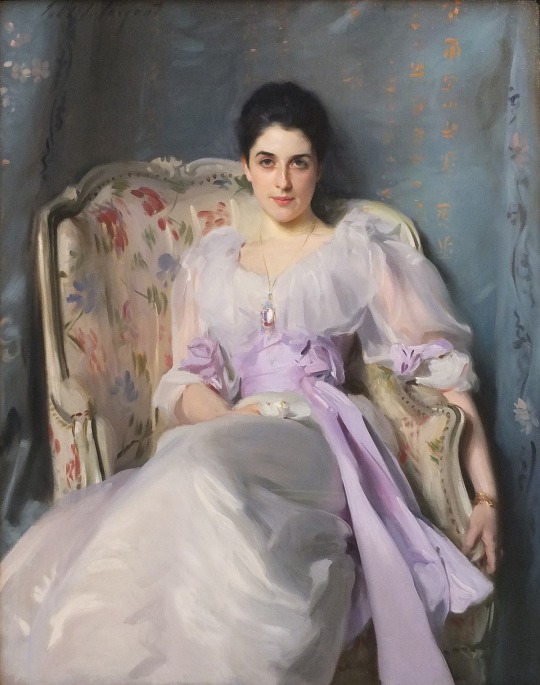
Oil painting, 1892, Scottish.
Painted by John Singer Sargent.
Portraying Lady Agnew in a white dress with a lilac sash
Scottish National Gallery.
#john singer sargent#lady Agnew#Gertrude Agnew#white#womenswear#dress#19th century#1890s#1890s painting#1890s britain#1890s Scotland#Britain#Scotland#1892#1890s dress#1890s womenswear#lilac#purple
227 notes
·
View notes
Text

37 notes
·
View notes
Text
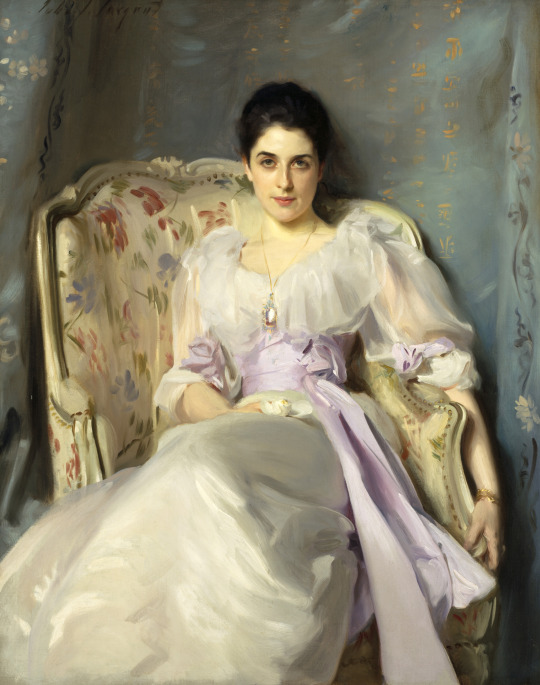
John Singer Sargent - Gertrude Vernon, Lady Agnew of Lochnaw (1864-1932)
399 notes
·
View notes
Text
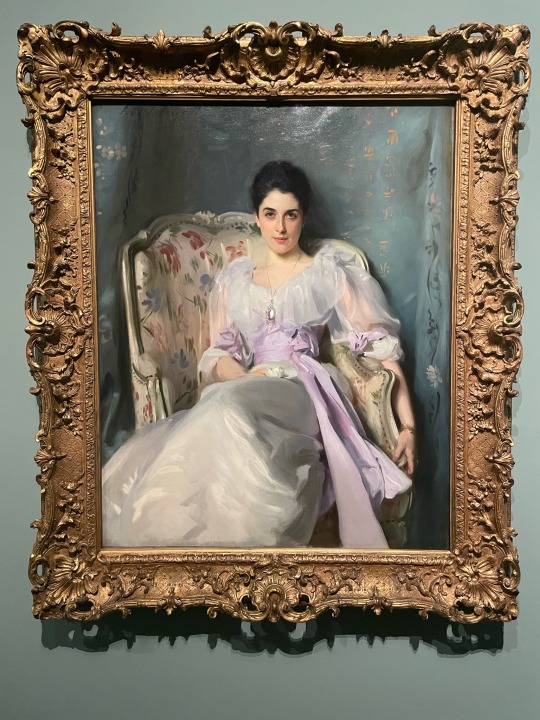
Lady Agnew of Lochnaw (Gertrude Vernon), 1892
Oil on canvas
Lady Agnew entertained frequently and enjoyed music, but she was delicate and often ill; when Sargent painted her, she was recovering from severe influenza. He visited Lady Agnew in her London home to discuss her portrait and to consider several different gowns. He chose one of white silk, with sheer organza sleeves and lavender trimmings. He painted quickly, using an economy of long diagonal strokes to render the lights and shadows that define the heavy cloth draped over her lap and the sensuous fall of her purple sash. The result —completed in just six sittings —was a triumph, and established Sargent's reputation as the premier portraitist in England.
"London is at his feet," wrote one friend.
22 notes
·
View notes
Text
I bought a print of this painting at the Scottish National Gallery. (Yeah, go on; it’s fine, you can say what you’re thinking…)

Entrance to the Cuiraing, Skye by Waller Hugh Paton
And I picked up a newfound appreciation for Lady Agnew as well. The painting was so striking in person.

Gertrude Vernon, Lady Agnew of Lochnaw by John Singer Sargent.
3 notes
·
View notes
Text

John Singer Sargent, Gertrude Vernon, Lady Agnew of Lochnaw
2 notes
·
View notes
Text
Mystery of the Tea Cup Quilt A Cozy Mystery: Harland Creek Mystery Quilters
Price: (as of – Details) Hi! I’m Dove Agnew, former successful dress designer who was living the high life in New York, until my sleazy business partner used my business to move his drugs, leaving me to pack my ruined reputation and move back home to the tiny town of Harland Creek. Despite the setback, all was going relatively well until I found Gertrude Brown’s body on the floor of my mom’s…

View On WordPress
#amazon ebooks for kindle unlimited#amazon kindle ebooks#amazon.in/ebooks kindle#can kindle tablets be used to access indian ebooks and audiobooks#chatgptʼ free kindle ebooks#ebooks jeffrey archer kindle version#ebooks kindle cart#ebooks kindle free for prime#ebooks kindle free for prime in tamil#ebooks kindle free novel series#ebooks kindle innovate and thrive jyoti yadav#ebooks kindle karachi to malabar an odyssey of love#ebooks kindle the golden road#ebooks kindle the psychology of money#ebooks kindle unlimited#ebooks kindle verity#ebooks kindle vortex#free kindle ebooks download#free kindle law ebooks#gujarati kindle ebooks#kindle ebooks by anupama jeremiah#kindle ebooks english#kindle ebooks english free#kindle ebooks for free#kindle ebooks for free tamil#kindle ebooks for kids#kindle ebooks free with prime#kindle ebooks hindi#kindle ebooks hyperspace#kindle ebooks in hindi
0 notes
Text
JOURNALING-
UNITY AND VARIETY- Unity is the simplicity in art, and variety is the complexity in art.

The unity in this artwork is the shapes and colors themselves. The variety is the way these shapes and colors are combined together to create a more complex design.
BALANCE- when all ends are leveled together and distributed equally

Leonardo Da Vinci's The Last Supper is another great example of symmetrical balance, drawing upon a one-point perspective in which the vanishing point is somewhere behind and above Christ in the center of the painting. An equal number of figures can be seen on either side of Christ, six on each side.
EMPHASIS AND SUBORDINATION- emphasis provides a magnification-like affect to a certain spot of an image, art, photograph, etc., creating a need for attention. Subordination is a low key form of expression that doesn’t draw as much attention.

The artist uses the color red to provide emphasis to the painting since the rest of the colors in the painting are more subtle and not as dramatic, providing subordination.
DIRECTIONAL FORCES- used to redirect the viewers attention to a specific part of an image

Although most of the content in this image is likely the same, they shift the focus of the eye from one bird to the other to imply the importance of it.
REPETITION AND RHYTHM- repetition is when the same thing occurs multiple times in one setting and rhythm is a tempo with recurrent features.

The drawing implies repetition because it has multiple columns spaced out one after the other. It includes rhythm due to the movement the columns provide through their recurrence.
SCALE AND PROPORTION- scale is the difference in weight/volume between different objects. Proportion is the difference in weight/volume of each of those objects’ parts before they are formed.

The scale between the chick and the man is incredibly different. The chick clearly outweighs the man. The proportion is the difference in the man’s face and his arms, or the difference between the chicks beak and trunk.
WRITING AND LOOKING-

Visual Elements PAGE 6/39 FIGURE: 3.11Paul D’Agostino’s artwork, The Rarely Glimpsed Junkfish implies positive/negative organic shape, irregular, linear perspective, solid blacks and browns, clay texture
CONNECTING ART TO YOUR WORLD-
I remember going into work one day upset and sad because my grandma has passed away. The room I was in had dark grey walls, dark blue cement floors, and metal equipment, which isn’t the friendliest of tones. The hue was dark and gloomy, and I could feel the aurora of the intensity of shades around me. However, right when I get off, I go over to a friends house to study for an exam and her house had white walls, high ceilings, bright yellow, pink, red, and light brown. Those colors provided vibrance and saturation which enlightened my mood. My energy levels began to rise again and my friend watched how the warmth of the colors boosted my spirits. I wear pretty neutral colors, but if I had to choose one color scheme to represent my life it would be red. I’m always alert, loving, sometimes angry, and full of health.
ART PROJECT: ARTISTS CHOICE-

I painted a sunset with a couple birds on the top right. The deep meaning behind this painting is that where I was originally born, Morocco, didn’t have sunsets in the area in which I lived. When I first moved to the U.S., I saw a beautiful sunset for the first time and it was the most incredible thing I had seen. Now, I try to go to the beach at least three to four times a week just so I’m able to watch the sunset. It’s truly beautiful what you can experience from different parts of the world and how much significance those things hold.
PHOTO/DESIGN-
Portraiture-

This is Lady Agnew, who was originally born as Gertrude Vernon. The portrait tells me that she was inherited into some kind of royalty family and her body language and clothing choice tells me she was very informal but lovely and vibrant.
Landscape- LINK ATTACHED BELOW!
https://www.istockphoto.com/photos/lake-wenatchee
Still Life-

This is a photograph of a basket of fruits by Nick Church. The author included this to capture a simple scene with a similar atmosphere and texture to high ranking painters. Church’s message was that he wanted a more natural and realistic style while still being able to create an authentic look.
0 notes
Text
This is the first* exemption to the standard post format, as this is the first post without a historical event from Emmy's life (at least I know of none that happened on this date). Instead, to bridge the gap until the next post (which won't come until May 8), I want to take a quick look behind the scenes.
Most of this blog would not have been possible without the work of Clark Kimberling. He has been a professor of mathematics at the University of Evansville, Indiana, since 1970 and did a lot of research about Emmy's life, corresponding both with Emmy's peers (or their descendants or other living relatives) as well as different archives (most prominently those of Bryn Mawr College and the Rockefeller Foundation) and donated copies of a lot of his letters and documents to my university's library.
An interaction which I found very interesting (and exemplary for the often times tedious work Kimberling had to go through) but which sadly didn't fit into any of the other posts was the following from correspondence with the archives of Bryn Mawr College:
Kimberling was in contact with George W. McKee, Emmy's sole Bryn Mawr Ph.D. student. In a letter to Anna Pell Wheeler, the head of Bryn Mawr's department of mathematics at the time of Emmy's stay there, there is a mention of an "E. Noether file" at Bryn Mawr, which Kimberling tries to find.
Thus, on April 4, 1968, Kimberling writes a letter to Professor John C. Oxtoby, the head of Bryn Mawr's department of mathematics at that time, asking whether there is any information about a "E. Noether file" at Bryn Mawr. On April 28, Oxtoby replies that he doesn't know anything about the file.
In research for an article about Emmy, on March 16, 1971, Kimberling writes to Janet Agnew, the Head Librarian of Bryn Mawr College, asking whether there is any information about a "E. Noether file" at Bryn Mawr. On April 26, Gertrude Reed, the Reference Librarian of Bryn Mawr College, replies to say that she also didn't find anything in the archives. She also tried to get in touch with the President’s Office, but they weren’t of much help, since "[m]ost of the material there is confidential." Kimberling also wrote to the office of Katherine McBride, the president of Bryn Mawr, directly on May 2, but apparently did not receive an answer.
On May 23, 1972, Kimberling again writes to McBride, sending a copy of his article (which was published in American Mathematical Monthly, Volume 79, Issue 2) and again asking about the "E. Noether file". On June 6 of the same year, Gertrude Reed writes to Kimberling again, saying that she finally found the "E. Noether file" in the archives, just a few months after Kimberling's article got published.
There will be a few other posts like this one that break the format and are mainly there to fill the gap between "historical" posts. Most of them will be photos of Emmy, there will be one in November giving a description of Emmy by one of her students at Bryn Mawr and another one in January about two of the places Emmy lived at in Göttingen.
*all filler posts will be tagged with #filler and most of them will just consist of photos of Emmy
0 notes
Text
Here are the Sargent portraits that I referenced so that you can see where I drew inspiration for this piece!
Mrs. Hugh Hammersley, John Singer Sargent (1892)
I specifically referenced the rug, giltwood furniture, that little round pillow, and her skintones.

Gertrude Vernon, Lady Agnew of Lochlaw, John Singer Sargent (1892)
Referenced for pose and expression.

Ena and Betty, Daughters of Asher and Mrs. Wertheimer, John Singer Sargent (1901)
The vase!

Lady Helen Vincent, Viscountess d'Abernon, John Singer Sargent (1904)
The hands playing with jewelry, expression.

Milicent, Duchess of Sutherland, John Singer Sargent (1904)
Skintone, colors of the dress and embroidery, expression.

The Daughters of Edward Darley Boit, John Singer Sargent (1882)
Back ground colors, the vases, the floor and rug


A Place to Call Home --- --- ---
This piece was commissioned by my dear friend @tawnyontumblr for HER dear friend @saretton to accompany a WONDERFUL fic that Tawny wrote for Saretton's birthday!
The fic is A Place to Call Home (Explicit, on AO3), a Human AU set in the Late Victorian/1890s and featuring Portrait Painter!Aziraphale and Stage Actor!Crowley as his artistic muse. I am in love with this concept.
Crowley's voice was almost too soft to hear. It nearly faded amidst the sweep of Aziraphale’s brush over canvas, the carriage rattling past outside—another layer of stimuli amidst the light, and the smell of linseed oil and turpentine. The way the fabric Crowley wore hissed gently over his skin as he slowly, minutely shifted position and then moved back.
He half sat half reclined on a Louis XVI armchair that Aziraphale had picked up in an estate sale. His legs were crossed, and the emerald banyan, embroidered with gold, slid from one shoulder. Aziraphale had been staring at that curve of lightly freckled skin while he'd been mixing rose madder and Chinese white, letting the brush sweep over the damp canvas as he sought to give voice to the hunger he felt.
The idea here was for me to paint the portrait of Crowley that Aziraphale is painting in the story.

Tawny asked me to paint with John Singer Sargent vibes, who is quite possibly my favorite artist of all time, and one of, if not the greatest, portrait painters of the 19th century. It's quite a tall order to try to imitate his style, so I settled for something Sargentesque! She also specified that "I want I am both painting and fucking him vibes. Intimate. That's the word." And I hope I delivered.




@goodomensafterdark Ya'll need to go read this fic its hot af.
I post all of my work, including the really filthy shit, full-sized WIPs, tutorials, comics, exclusive pieces, and more on my on my Patreon
A print of this piece will be up in my print shop on INPRNT!
507 notes
·
View notes
Text

John Singer Sargent, Lady Agnew of Lochnaw - c.1892-93
2K notes
·
View notes
Photo

I think of something I read about Sargent: how in portraiture, Sargent always looked for the animal in the sitter (a tendency that, once I knew to look for it, I saw everywhere in his work: in the long foxy noses and pointed ears of Sargent’s heiresses, in his rabbit-toothed intellectuals and leonine captains of industry, his plump, owl-faced children).
- Donna Tartt, The Goldfinch
John Singer Sargent’s reputation among art critics has risen, fallen, and risen again. He was once among the most celebrated painters in Europe and America. He scandalised Paris with his painting Madame X, helped inspire The Picture of Dorian Gray, and was made the official artist of World War I. But when he died in 1925, artistic trends were already turning against representational art, and lush paintings of wealthy industrialists’ wives had become politically incorrect. In 1931, Lewis Mumford called him a mere “illustrator,” whose work was characterized by “contemptuous and cynical superficiality.”
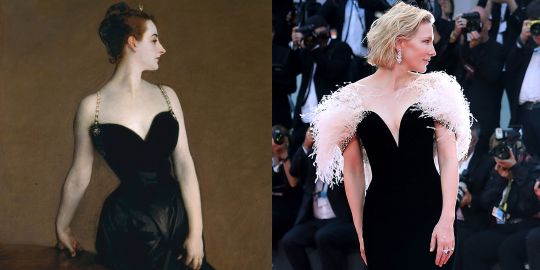
Madame X by John Singer Sargent
Born in Italy to American parents, Sargent lived most of his life in Europe. He studied in the Paris studio of Carolus-Duran, and his major influences were Velazquez and the French impressionists. The latter were personal friends, particularly Claude Monet and Paul Helleu, with whom he often painted. But his style was distinct, especially his use of dark contrasts. According to one revealing story, Sargent once ran out of black paint and asked to borrow some from Monet, only to find that the Frenchman didn’t carry any.
He adapted from the impressionists his characteristic style of bold brushstrokes and tricks such as the glob of white paint that gives the necklace in Lady Agnew of Lochnaw a glimmering 3D effect. Examined up close, Sargent’s paintings appear like streaks of colour that couldn’t possibly make up the more-than-real images one actually sees when one steps back. And he combined this deceptive precision with a mastery of shading, which he enjoyed demonstrating by painting white-on-white - a demanding trick that under his brush seems like hardly any bother. As is usually the case, such apparent effortlessness was the product of painstaking discipline. His 1886 Carnation, Lily, Lily, Rose took months to complete, because he could paint only for a few minutes each evening when the light was perfect.
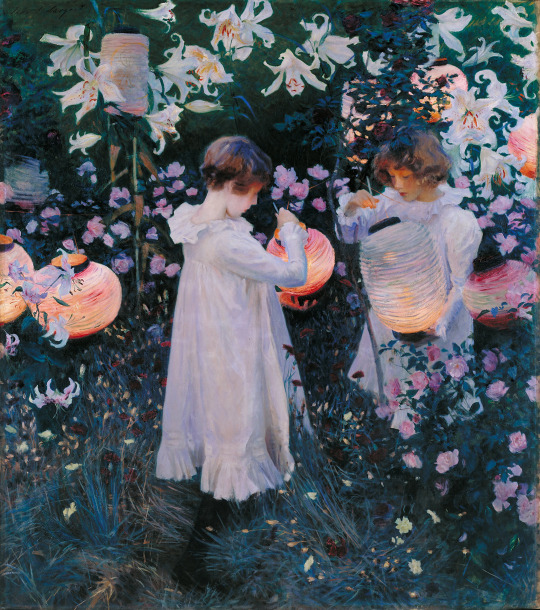
Carnation, Lily, Lily, Rose by John Singer Sargent
Sargent was also skilled at selecting poses that bring his subjects to life. Instead of forcing Homer St. Gaudens into a stale, statuesque position, he captured the boy’s candid, slouching boredom. Édouard and Marie-Louise Pailleron sit like they’re about to disclose some haunting secret. And Pamela, the middle Wyndham Sister, fiddles idly with her ring like the flirtatious dynamo she was. Yet his works don’t descend into bland, documentary naturalism. On the contrary, these realistic touches amplify the glamorous, sometimes otherworldly beauty that Sargent drew out of real people.

His skill at abstraction often makes his portraits more like windows into an ideal world than faithful depictions of his models. Consider Mrs. Fiske Warren and Her Daughter Rachel, now on display at the Gardner alongside a photo of the two posing. They’re by no means ugly, but on canvas, they become what they no doubt wished they were. “Women don’t ask you to make them beautiful,” he wrote, “but you can feel them wanting you to.”

Lady Agnew of Lochnaw by John Singer Sargent, National Galleries of Scotland
Or consider his greatest portrait, Lady Agnew. The real Gertrude Vernon was a moderately attractive noblewoman who was ill much of her life, including when the artist was working. But the painting, finished in just six sittings with no preliminary sketches, transcends reality. She vibrates with a liveliness only thinly veiled with nonchalance, just as the translucent sleeves of her gown shield the arms beneath. Her leisurely pose, on one hip diagonal with the chair, contrasts with the hypnotic attentiveness of her gaze, giving the impression - to borrow a line from Sargent’s contemporary, Joseph Conrad - of “the stillness of an implacable force brooding over an inscrutable intention.” Lady Agnew goes beyond formal portraiture, and transports the viewer into a realm of elegance and intrigue.
Despite efforts by later critics to marginalise his work, Sargent influenced generations of painters - from John White Alexander to Daniel E. Greene to Ariana Richards. Perhaps his finest admirer in recent years was Pino Daeni, whose sensual oils adapted Sargent’s sweeping brush strokes and lively poses to a more exotic color palette. One can only hope that more people can give Sargent his artistic due. As the master of elevated grace, his legacy will forever be cherished by those who long for an art that expresses life as it could and ought to be.
#tartt#donna tartt#quote#john singer sargent#sargent#art#artist#painter#portraiture#arts#aesthetics#beauty#culture#impressionism#paintings#fine art
179 notes
·
View notes
Text

Portrait painting of lady Gertrude Agnew,, the wife of Sir Andrew Agnew..
Oil on canvas..
Painting by John Singer Sargent,, (1892-1893)..
7 notes
·
View notes
Photo

Lady Agnew of Lochnaw (1892). John Singer Sargent (American, 1856-1925). Oil on canvas. Scottish National Gallery.
This portrait of the renowned society beauty Lady Agnew (née Gertrude Vernon) was commissioned by her husband, Sir Andrew Noel Agnew, a Scottish barrister. Through her direct, frontal gaze and the informality of her pose, the subject forges a compelling connection with the viewer. The colorful, patterned upholstery of the 18th-century French armchair and silk Chinese wall hanging harmonize with her elegant white gown trimmed in lilac. Sargent’s fluid brushwork conveys a sense of opulence and ease. The outpouring of praise the work received when exhibited at London’s Royal Academy in 1893 launched Lady Agnew as a society hostess and the painter’s reputation as the most fashionable portraitist on both sides of the Atlantic.
84 notes
·
View notes
Text
Mostly Mezzo Mondays: Piau, Coote, Graham, Watson, Connolly (x3), Clayton, Hannigan, Crebassa, & many more
Mostly Mezzo Mondays: a recurring (though not weekly) feature where, on Monday nights, I blog a list of the upcoming broadcasts that have caught my eye on World Concert Hall. My interests: baroque vocal music, art song recitals, and a list of favorite singers.
Sandrine Piau is among the soloists for a performance of Jommelli’s Requiem recorded late last year. (The same team can be heard in the previous day’s performance on YouTube.) Deferred broadcast Tuesday, August 11 on WDR 3.
Sarah Connolly sings a recital of works by Debussy, Schoenberg, Eisler, Zemlinsky, Poulenc, Strauss, and Korngold, accompanied by Malcolm Martineau. Re-broadcast Wednesday, August 12 on BBC Radio 3.*
Sarah Connolly sings the role of Dido in a performance of Purcell’s Dido and Aeneas recorded at the 2003 Proms. Other notables in the cast include Christopher Purves as Aeneas and Carolyn Sampson as Belinda. Archival broadcast Thursday, August 13 on BBC Radio 3.*
Alice Coote is among the soloists for a performance of Mahler’s Des Knaben Wunderhorn conducted by Herreweghe in 2010. Second part of an archival broadcast program Saturday, August 15 on NPO Radio 4.
Susan Graham sings the Composer in a production of Strauss’s Ariadne auf Naxos recorded at the Houston Grand Opera in 2011; Christine Goerke and Laura Claycomb are among her co-stars. Archival broadcast Saturday, August 15 on HPM Classical.
Katherine Watson sings a small selection of Handel arias as part of a baroque concert with the Orchestra of the Age of Enlightenment recorded in 2018. Deferred broadcast Saturday, August 15 on Radio Clásica.
As part of its free online streaming program this summer, Glyndebourne will be showing the 2017 world premiere of Brett Dean’s Hamlet. The show stars, among others, Allan Clayton (Hamlet), Sarah Connolly (Gertrude), Rod Gilfry (Claudius), Barbara Hannigan (Ophelia), and John Tomlinson (Ghost, Player King, and Gravedigger). I had the pleasure of seeing this production live; I was there for Connolly’s Gertrude (“on excellent form, all tiaras and condescension and cracking veneer” as one reviewer put it), but Clayton’s outstanding performance in the marathon title role blew me away, and Hannigan’s live-wire Ophelia was quite memorable, too. Video stream Sunday, August 16 on the Glyndebourne website; should remain available for a week. (Looks like this will be geoblocked in France and Japan.)
I don’t have a particular favorite to call out, but the cast of this Saul from the 2003 Proms is strong all around: Neal Davies, Andreas Scholl, Deborah York, Susan Gritton, Mark Padmore, Paul Agnew, and Jonathan Lemalu. Archival broadcast Sunday, August 16 on BBC Radio 3.
Beethoven’s Ninth is arguably just the thing to lift our mid-pandemic spirits, although the fact that it is being performed live in Salzburg while live performance of large-scale classical works remains ethically impossible in my own country (due to horrendously inadequate responses to the public health crisis on the part of both the leadership and the public) makes me feel just a little bit bitter about putting it on this list. The names of vocal soloists Marianne Crebassa and Gerald Finley caught my eye; I can’t say I am as familiar with the work of Asmik Grigorian and Saimir Pirgu, but I trust they’re up to snuff. Deferred (only by three days) video stream on Arte Concert. (May be geoblocked.)
* The two broadcast marked with asterisks are not featured on World Concert Hall; these links go directly to the BBC Radio 3 site.
#opera tag#sarah connolly#alice coote#barbara hannigan#susan graham#sandrine piau#katherine watson#allan clayton#marianne crebassa#gerald finley#rod gilfry#john tomlinson#mostly mezzo mondays
2 notes
·
View notes